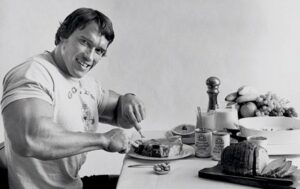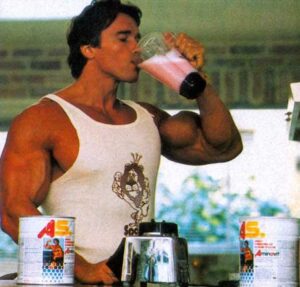What started as a cure for illness is now a muscle-building must for strength athletes.
Protein powders are big business. Prior to the pandemic, it was estimated that in the United States alone consumers spent billions of dollars a year on protein supplements. (1) Pre-made protein shakes and protein-enriched foods are available in airports, grocery stores, and vending machines. If you saw someone walking down the street sporting a protein shaker, you wouldn’t think twice. Protein powders aren’t just for gym rats, either. Plenty of people take them as a way to simply up their protein intake or fill gaps in a protein-deficient diet.
This shouldn’t come as a surprise. After all, protein powders represent one of the easiest ways of increasing one’s protein intake with relatively little effort. The centrality of the protein shake in many people’s lives represents the success of fitness marketing across several decades. Like many other aspects of the fitness industry, the popularity of protein shakes only emerged in the mid-twentieth-century when people like Joe Weider, Bob Hoffman, and Rheo H. Blair began promoting a new generation of supplements.
But the history of protein powders, and supplements in general, is a longer story, one which has undergone numerous changes over time. When were protein shakes invented? Who first advertised them? And, more importantly, how did they become commonplace in the fitness industry?

The Origins of Protein Powders
The first modern protein powder was not made for the fitness industry. It was designed to be used in hospitals to help restore the strength of undernourished patients. In the late nineteenth century, a dried milk-powder treatment known as Plasmon was created in German hospitals. (2)
Plasmon was tasteless, odorless, and, importantly, high in protein. Within the space of a decade, Plasmon went from being a cure for the sick to a strengthening aid for the first wave of modern bodybuilders.
How nutritious was it? Plasmon’s later advertisements claimed that a single teaspoon (four grams) of Plasmon held the protein equivalent of two eggs or 12 grams of protein. (3) To put that into context, many protein powders serve up between 20 and 30 grams of protein per serving (which is around 30 to 40 grams). Accepting that measuring nutrients was not as accurate as it is today, Plasmon was likely similar to your average protein powder.
What distinguished Plasmon from later supplements was its medical backing. In the late 1800s, German physician Dr. C.R. Virchow issued a report on Plasmon for the German government. The report claimed that Plasmon was more advantageous than meat for strength, endurance, and vitality. Described as ‘the albumen of pure fresh milk in the form of a dry, soluble granulated, cream-white powder,’ Plasmon was viewed by many German physicians in the late-nineteenth-century as a wonder substance. (4)
Then, in 1899, a small group of British businessmen secured the rights to sell Plasmon outside of Germany. They were not interested in medicine, but money. In 1904 ‘International Plasmon Limited’ began marketing the product for both the general public and, importantly, athletes. (5)
While German doctors used Plasmon as a medical treatment in hospitals, Plasmon became an athletic aid in Great Britain. From 1904 to the outbreak of the Great War in 1914, Plasmon sponsored numerous athletes and physical culturists to market Plasmon to the average exerciser.
IFBNewsfeed.Org has published several articles on the birth of ‘physical culture’ in the early 1900s. As a quick reminder, physical culture is generally regarded as the moment when weightlifting, bodybuilding, and gym cultures grew in popularity. Plasmon was part of this wave.
Included in Plasmon’s stable of sponsored athletes were vegetarian tennis player turned physical culturist Eustace Miles, versatile British athlete C.B. Fry and, ‘Father of Modern Bodybuilding’ Eugen Sandow. Sandow’s endorsement, in particular, helped propel Plasmon’s popularity in fitness cultures.
In the mid-1900s, Sandow was regarded as the world’s most perfectly developed’ man and one of the strongest men in the world. When Sandow told fans in 1906 that Plasmon was the only supplement he used, people took notice. (6) Not only did Sandow describe Plasmon as the highest protein food he ate, but he also claimed that it was possible for physical culturists to survive and thrive solely using Plasmon.
What was interesting about Plasmon was that it was promoted as a standalone supplement and something that could be added to existing meals. In 1903, Plasmon International Limited published the Plasmon Cookery Book. Aimed at both the housewife and the athlete, the cookbook tried to convince users to make Plasmon soups, stews, and bread. Put simply, this was an early example of the protein mania our society now enjoys. (7)
But Plasmon’s popularity was not to last. When the Great War began in 1914, International Plasmon Limited found it increasingly difficult to import ingredients into Britain. The product disappeared from Britain halfway through the war and with it, protein powders for athletes and gym-goers largely vanished.
Enter The New Wave of Protein Powders
While there is some evidence that bodybuilders and weightlifters used dried milk powder in the inter-war period (1918-1939), it was not until the mid-1950s that protein powders began to be marketed again. (8) The reason for this was quite simple, bodybuilding entrepreneurs were largely ignorant about nutrition.
Several years ago John Fair and Daniel Hall published an article on the birth of protein supplements in America. As part of their research, the two men uncovered a meeting between Bob Hoffman and Paul Bragg in the 1940s.
For those who don’t know, Paul Bragg was one of the most successful celebrity nutritionists in the United States. During his career, Bragg published numerous books, toured the country giving lectures on health, and sold several supplements, many of which still exist today. (9)

Because of his interest in nutrition, Bragg also had connections in the fitness industry. The great television exerciser, Jack LaLanne, claimed that Bragg convinced him to live a healthy lifestyle. In 1946 Bragg met with York Barbell founder and American weightlifting coach Bob Hoffman to create supplements for weightlifters. Bragg left disappointed when it became clear that Hoffman didn’t understand the importance of supplements or nutrition.
As Fair and Hall found, Hoffman’s dietary knowledge was very basic and largely revolved around the idea that weightlifters and bodybuilders should eat moderate amounts of protein (.45 grams of protein per pound of bodyweight). Hoffman wasn’t alone either. The owner of Iron Man magazine, Peary Rader, published an article on diets for strength athletes in 1948 with the following words of wisdom
“The diet of most successful bodybuilders is just the average well-rounded diet…” (10)
It was not until the mid-1950s that supplement salesman Irving Johnson helped re-create the protein mania Sandow ushered in during the early 1900s. In December 1950, Johnson published an article in Iron Man magazine entitled ‘Build Bigger Biceps Faster with Food Supplements.’ (11)
Johnson’s claims about the protein powder he was selling were nothing short of miraculous. Using examples from teenage weightlifters in his gym, Johnson claimed to have increased the boys’ weight and strength through his protein powders. By 1951, ‘Irving Johnson’s Hi-Protein Food’ was advertised in Iron Man using even more testimonials about massive weight gains under Johnson’s supplement regimen. (12)
Unsurprisingly given Johnson’s claims, he met with a great deal of success. Others in the fitness industry took notice. In 1952 Bob Hoffman began selling his own ‘Hi-Protein’ soy protein powder. Prior to this point, Hoffman let Johnson run advertisements for ‘Hi-Protein in his Strength and Health magazine. (13) When he began selling his own protein powder, he removed any reference to Johnson in his magazines.
Hoffman was soon joined by Joe Weider — the founder of the Mr. Olympia contest and famed muscle magazine magnate — and several others selling protein powders to the general public. Within a few years, the popularity of protein powders, and their reputation within the fitness industry, was undisputed. Two things motivated this evolution, the development of anabolic steroids and the ‘golden age’ of bodybuilding.
Protein Powder in the Golden Age of Bodybuilding
IFBNewsfeed.Org’s existing article on the development of body part splits in the 1950s and 1960s has explained the influence anabolic steroids had in the fitness industry. As a quick refresher, anabolic steroids began to be used by weightlifters in America at the end of the 1950s. Many of these weightlifters were coached by Bob Hoffman, who also sold ‘Hi-Protein.’

As weightlifters and bodybuilders began to increase in size and strength, Hoffman and others began claiming that it was their protein powders responsible for these improvements. At this time the average gym-goer had little knowledge of anabolic steroids or their effects. Thus when Hoffman, Weider, and others claimed that their protein powder caused rapid gains in strength and size, many believed them. (14)
Illustrative of this advertising approach was the return of Rheo H. Blair aka Irvin Johnson. Hoffman ousted Johnson from Strength and Health magazine in 1952. Soon after, Peary Rader stopped publishing Johnson’s advertisements. Seeking a new start, Johnson moved from Chicago to California, changed his name to Rheo H. Blair, and began selling new milk-based protein powders to the golden generation of American bodybuilders. (15)
It was Blair’s protein powders that bodybuilders and weightlifters coveted during the 1960s. Blair was one of the first fitness manufacturers since Plasmon in the early 1900s to produce a milk protein powder. Mixing his protein powder with raw milk and/or cream, Blair claimed that his supplements produced the anabolic effects many would associate with anabolic steroids. (16)
Blair’s advertisements spoke of 20 to 30-pound muscle gains in a relatively short period of time solely using his protein. In some quarters, people indeed claimed that Blair’s protein powder was more effective than anabolic steroids. (17)
This led many to believe that protein powders were responsible for these gains. That bodybuilders used protein powders and advertised them further complicated this development. Anabolic steroids were important but so too was the ‘golden age’ of American bodybuilding which began in the 1960s and continued into the 1970s.
Bodybuilding magazines from this period began featuring articles written by people like Arnold Schwarzenegger, Franco Columbu, and Frank Zane on the benefits of a particular protein powder. (18) Likewise, advertisements in fitness magazines showed bodybuilding champions beside their favored supplement. This helped push the popularity of protein powders even more.

One quirky example of this is that patents for shakers bottles — the devices we all use to mix our protein shakers — multiplied during the 1970s and 1980s as consumers and producers sought to make consuming shakes an easier experience. (19) The very existence of protein shakers demonstrated the increased popularity of protein supplements as people wanted to consume them with greater regularity.
Nowadays, there’s a variety of protein shakes — from whey protein powders to protein shakes for vegans, to shakes for weight loss. It is, indeed, a giant industry.
So returning to the question from the beginning of this article, when was the protein shake invented? That answer is easy, the late nineteenth century. When were they first advertised to produce a similar answer? It is only when we get to the popularity of protein shakes that things get a little more complicated.
Plasmon, the protein powder advertised by Eugen Sandow and others, was undoubtedly popular for a brief period of time in Great Britain but, with the outbreak of World War One, it largely disappeared from the fitness industry. It was only in the mid to late twentieth-century that protein powders became, and remained, popular. It was a combination of new sales tactics, steroids, and a rising interest in nutrition that helped make protein powders a mainstay for lifters today. There should be little doubt then that protein powders were born in the bodybuilding industry and, from there, came to influence the entirety of the fitness field.
References
- Daniells, Stephen , ‘Protein Powders: The Heavyweights in the 16 billion dollar sport nutrition market,’ Food Navigator USA, 19 December 2018. https://www.foodnavigator-usa.com/Article/2015/09/17/Protein-powders-The-heavyweight-in-the-16bn-sports-nutrition-market.
- Heffernan, Conor. “Superfood or Superficial? Plasmon and the Birth of the Supplement Industry.” Journal of Sport History 47.3 (2020): 243-262.
- Roach, Randy, ‘Splendid Specimens: The History of Nutrition in Bodybuilding,’ Weston Price, 14 December 2004. https://www.westonaprice.org/health-topics/splendid-specimens-the-history-of-nutrition-in-bodybuilding/
- Hall, Daniel T., and John D. Fair. “The pioneers of protein.” Iron Game History 8.3 (2004): 23-34.
- Murtha, Ryan, Conor Heffernan, and Thomas Hunt. “Definition Diets and Deteriorating Masculinity? Bodybuilding Diets in Mid-Century America.” Global Food History (2021): 1-21.
- Murtha, Heffernan, and Hunt. “Definition Diets and Deteriorating Masculinity?”
- Boyle, Ellexis. “Marketing muscular masculinity in Arnold: the education of a bodybuilder.” Journal of Gender Studies 19.2 (2010): 153-166.
- Heffernan, Conor, ‘The History of Protein Shakers,’ Physical Culture Study, 11 July 2018. https://physicalculturestudy.com/2018/07/11/the-history-of-protein-shakers/






